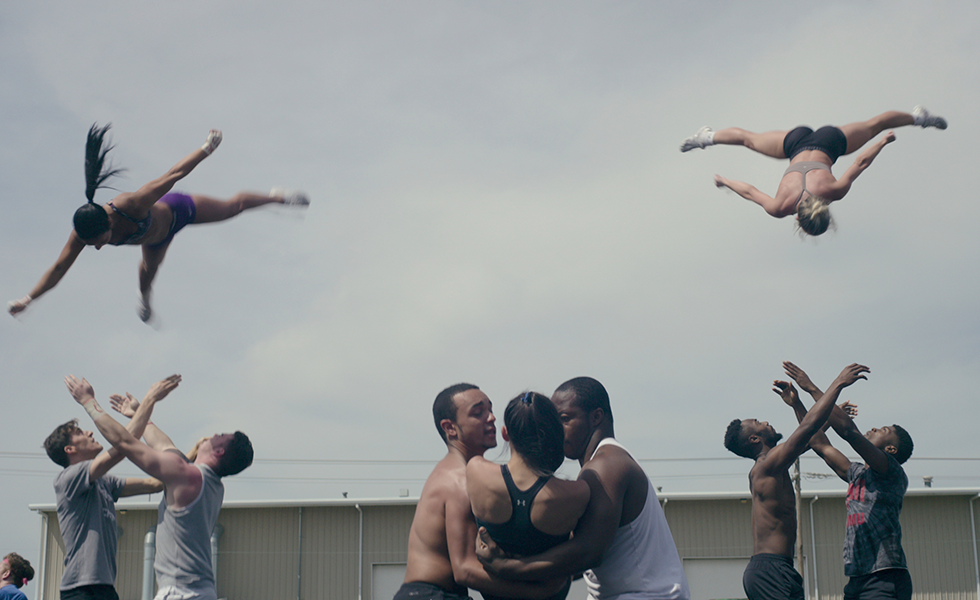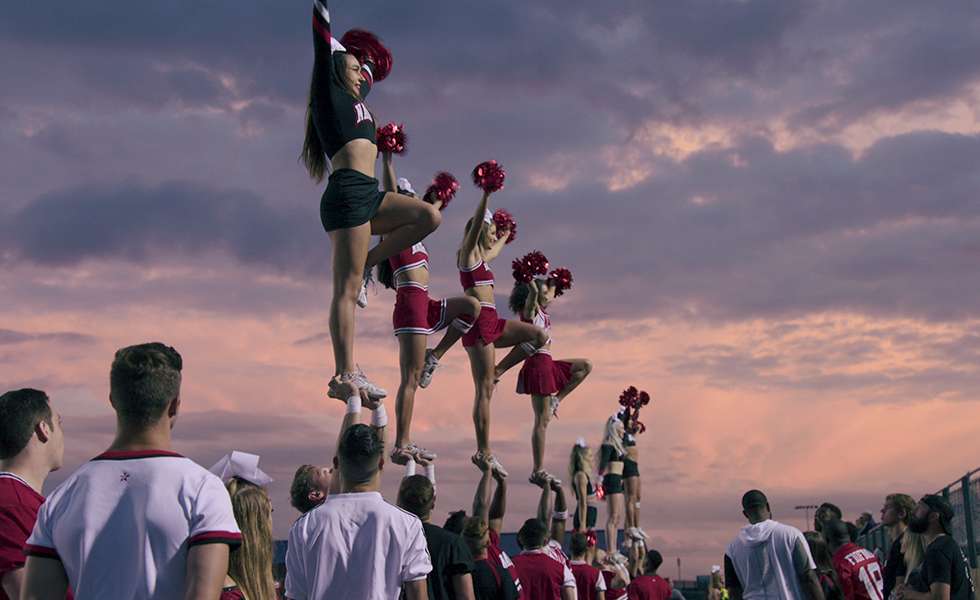My nose hovered just centimeters above the scuffed basketball court, legs folded beneath me in a perfect Z, my back flat enough to serve tea on. As a chugging synth melody filled the gym, I felt my dread growing. I stayed perfectly still until the refrain, when I began pulsing my upper body to repeated proclamations that “We like to party.” I snuck a sideways look at my teammate beside me. She, like me, was wearing a bald cap, lensless Buddy Holly glasses, and a men’s suit. And in another eight-count, she, like me, would snap her head up to face a pep rally crowd of her teenage peers while dressed as the old man from the Six Flags commercial.
As I moved through the routine—a rote smile plastered on my face as I did the cabbage patch, the running man—I thought of the many hours of work we had done in the studio down the hall. I thought of the competitions we’d swept, the technical routines we’d perfected, the injuries and tears. And as laughter filled the gym, I thought about how my athleticism and art would now be defined by a moment where I was dressed in my dad’s old suit.
The indignity of that routine from my dance team career at Huntsville High School came back to me—as clear as if someone put the Vengaboys on at a party—as I watched Netflix’s documentary series Cheer. The show, released in full last week, follows Texas’ decorated Navarro College cheerleading squad as they prepare for the National Cheerleaders Association College championship in Daytona Beach, Florida. But in the first of six hourlong episodes, the team takes a break from its rigorous schedule training for the Olympics of cheerleading to perform at a benefit for the hometown crowd in Corsicana, south of Dallas. The performance is a far-cry from the Bulldogs’ typical routine: The women on the team pull on boots and daisy dukes and perform cutesy line dance-inspired choreography to “God Blessed Texas.” The stunting and tumbling are minimal and sanitized for a small stage.
Cheer gives the world of competitive cheerleading its much-needed due, chronicling the feats of strength and precision required to regularly bend the laws of physics. Forget toe touches and herkies, the Navarro squad’s sub-three minute competition routine featured a pyramid so complicated that it took athletes down left and right. Director Greg Whiteley (best known for Last Chance U, which focused on small university football programs) has said unequivocally that cheerleaders are “the toughest athletes I’ve ever filmed.” Navarro epitomizes that toughness. The program has taken home 14 NCA division titles and five overall grand championships. But that night in Corsicana, they’re largely reduced to the most elemental of Texas cheerleading stereotypes: boots and pompoms.

Despite having one of the top cheerleading programs in the world right in their backyard, most Corsicanans on the show—like most of the world—seem barely aware how competitive Navarro’s cheerleading program is. (When the filmmakers ask about their perception of cheerleading, most of the locals cite the Dallas Cowboys cheerleaders as the exemplars of the sport.) Interviews interspersed throughout the series reveal the root of a still-pervasive image. Cheerleading, after all, was predicated on the basis that there is a team to cheer on. Early conventions in the 1950s and ’60s not only taught jumps and kick techniques, but what it meant to act like a cheerleader (be positive and learn the rules of football!), to look like a cheerleader (big hair and perfect lipstick!), all in the name of hyping a crowd for the boys on the field. It became not only an activity, but a persona.
Cheerleading, however, has far outstripped those beginnings. By the 1980s, independent competitions began growing in popularity, and the focus shifted away from sideline routines to basket tosses, twisting tumbling passes, and towering pyramids. Gyms dedicated to competitive cheerleading proliferated, training kids from the age of 5 in this hybrid of gymnastics, acrobatics, and dance. Coed teams in all levels of competition became more common as stunting grew more elaborate. Routines grew more technical—and dangerous. The documentary notes that among female athletes, cheerleading accounts for the highest rate in any sport of so-called catastrophic injuries, which can include fractured skulls and serious blows to the spinal cord. It’s getting harder and harder to win the tired argument that cheerleading is not a sport.
Even as the focus of college-level and many high school squads has shifted to training for jam-packed competition routines with stunt sequences and gymnast-level tumbling, the point of reference for many are sideline and halftime performances—the only time most people encounter the sport. As Cheer explores, the NCA Championship, the most prestigious national collegiate cheerleading competition, is tightly guarded from distribution on major networks by its owner, Varsity Brands. Unless you tune in through Varsity’s proprietary channel or show up to Daytona Beach, there are no options to watch the sport’s athletes compete at the highest level. Varsity, a multibillion-dollar company, so closely protects its IP that even the Cheer film crew was blocked from entering. Whiteley and his team get creative, thwarting a potentially anticlimactic end to the project.
But the view that cheerleaders are mere sideline entertainment likely persists more from general apathy than lack of access. As the Navarro cheerleaders prepare for a basketball game—once again interrupting their training schedule—one team member laments that though the squad shows up to cheer: “When we go to Daytona, no one cares.”
That’s an experience I know all too well. Most of my fall Friday nights were spent doing pom routines in the football stands and performing with the band during halftime, and for many that became the image of what our team had to offer: simple routines with big moves that could be seen from the stands, done in glittery overlays paired with cowboy hats and short flared skirts. Mostly, we danced while people went to buy Frito pie.

No one on my team lived or sweated for those nights. Our true focus was always trained on the spring, when we added hours to our practice schedule to prepare for competition season—tackling routines that required a much higher level of skill and finesse. We were rewarded and recognized for that work. Weekend after weekend we returned to school with more trophies than our perennially awful football team could shake a stick at. And yet, those were secluded victories, largely celebrated only by ourselves. Mostly, I expect, it was because when we were no longer accessories to jocks, we stopped mattering.
In a strange way, so much of cheerleading and any other sport performed for judging panels reinforces the idea of women as ornaments. Although Navarro is a coed squad of elite athletes, the women on the team face pressure not only to execute, but to look good while doing it. (There are more than a few hints at the resentment the women feel about having to block out an extra two hours ahead of appearances to go through extensive hair and makeup, which their male counterparts don’t have to do). Watching them prep, I had acid flashbacks to the hideous Mary Kay sets the whole team had to order, my scalp tingling in anticipation of my hair being yanked into a French braid.
Cheer, however, doesn’t dwell on such well-established dichotomies. Rather, it focuses on the grueling practices when the Navarro squad risks career-ending injuries every day. It spotlights the take-no-shit coach Monica Aldama, a rare blend of both Coach and Tami Taylor. And, perhaps most importantly, it delves into the complex life stories of the individuals who make up the team, portraying their resilience beyond their physical skills. You know, like a real sports documentary.
When I visited my parents’ house over the holidays, there was a new addition to my former bedroom: my freshman dance team portrait. I stood against a brown backdrop in my football performance uniform, leg propped on a step stool, my foot pointing hard in white Keds. A cowboy hat covered my long, straightened hair, the sequins on my overlay making my ill-advised blonde highlights glow green. That, maybe more than our Six Flags outfit, is probably how our team was best remembered—the polished girls wearing red lipstick for the halftime show.
I remember thinking at the time that I was lucky that the picture didn’t show any of the black and blue patches I’d sustained during extended practices, that my swollen ankle was covered by tall socks. The most powerful thing about Cheer is that what Navarro makes look easy and beautiful is only accomplished through untold hours and dedication. I wish that photo showed my bruises.
READ MORE:
-
Ken Paxton Says New Anti-Abortion Law Bars State Employees from Donating to Planned Parenthood?: Advocates warn that the attorney general’s new opinion indicates how far efforts to implement a vague new law could go.
-
The Return of Karl Rove: Political strategist and pundit Karl Rove was an architect of the GOP takeover of Texas in the 1980s. Now, he’s come home to ensure Trump doesn’t unravel his legacy.
-
Hemp Snafu Offers Texas Cities a Way to Decriminalize Marijuana: Austin leaders will consider a proposal to effectively end enforcement of misdemeanor pot possession.







